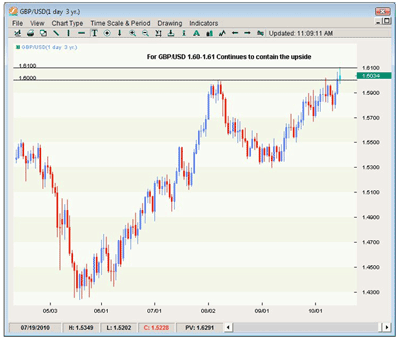On Friday, Federal Reserve chairman Ben Bernanke confirmed what everyone in the currency market had known for weeks: QE2 (the second round of quantitative easing) is coming.
"With growth in private final demand having so far proved relatively modest, overall economic growth has been proceeding at a pace that is less vigorous than we would like…There would appear—all else being equal—to be a case for further action,” the chairman said.
FX Reaction
With those words, high-beta currencies skyrocketed. The aussie finally hit parity, the euro pushed through 1.4150, and cable took out the 1.6100 figure.
However, just as quickly as they rose, risk currencies retreated as profit taking kicked in. The euro tumbled all the way through the 1.4000 level, while the aussie fell more than a penny after setting a record high at 1.0002. The reason for the retreat was the fact that much of the impact of Bernanke’s remarks was already factored into the prices, and Friday’s speech offered little fresh information except to confirm that further monetary accommodation will take place.
Chairman Bernanke noted that the Fed will “Proceed with some caution,” suggesting that the FOMC will be highly data dependent in setting the size of the QE2 program. With the market anticipating at least $500 billion worth of easing, any number less than that could actually prove to be dollar positive as the Fed alleviates fears over the dilution of the dollar.
The Pound
One currency, however, that saw only the shallowest of corrections was the pound, which continues to benefit not only from anti-dollar flows, but from the perception that the Bank of England (BOE) will not engage in any additional QE.
Last Friday, cable bulls found some support from the ex-Monetary Policy Committee (MPC) member Rachel Lomax, who stated that she would be reluctant to expand the central bank’s stimulus program and said such measures risk fueling asset bubbles, noting that further quantitative easing “Makes me fairly queasy.” Yet while such hawkish rhetoric clearly provides a boost for sterling, I remain convinced that the unit is vulnerable to a selloff into year-end.
Upcoming Data
This week should prove to be pivotal for the pound as markets get to see the latest MPC minutes on Wednesday, October 20 at 4:30 am ET and the retail sales report on Thursday, October 21 at the same time.
Most importantly, on Wednesday, chancellor Osborne’s report on the comprehensive spending review will reveal how budget austerity measures are to be implemented. I continue to believe that a combination of lackluster private demand and sharp reduction in public spending could derail the UK’s fragile recovery and tip the country back into a recession, prompting a fall in the currency.
Cable therefore could be ripe for a correction if the economic data misses expectations and the austerity cuts prove to be more draconian than the market imagines.
Pound: Key Levels
Although the pair briefly broke through the 1.6100 level, it remains contained by the broad 1.6000-1.6100 band as it explores the upper end of its range.
See Figure 1, courtesy of FX Trek by Intellicharts. In order for it to clear resistance, sterling would need to hold above the 1.6150 level on a closing day basis. If it is unable to clear this hurdle, the pair could quickly drop towards 1.5500 over the next several weeks as disappointment sets in.
By Boris Schlossberg of BKForexAdvisors.com






















